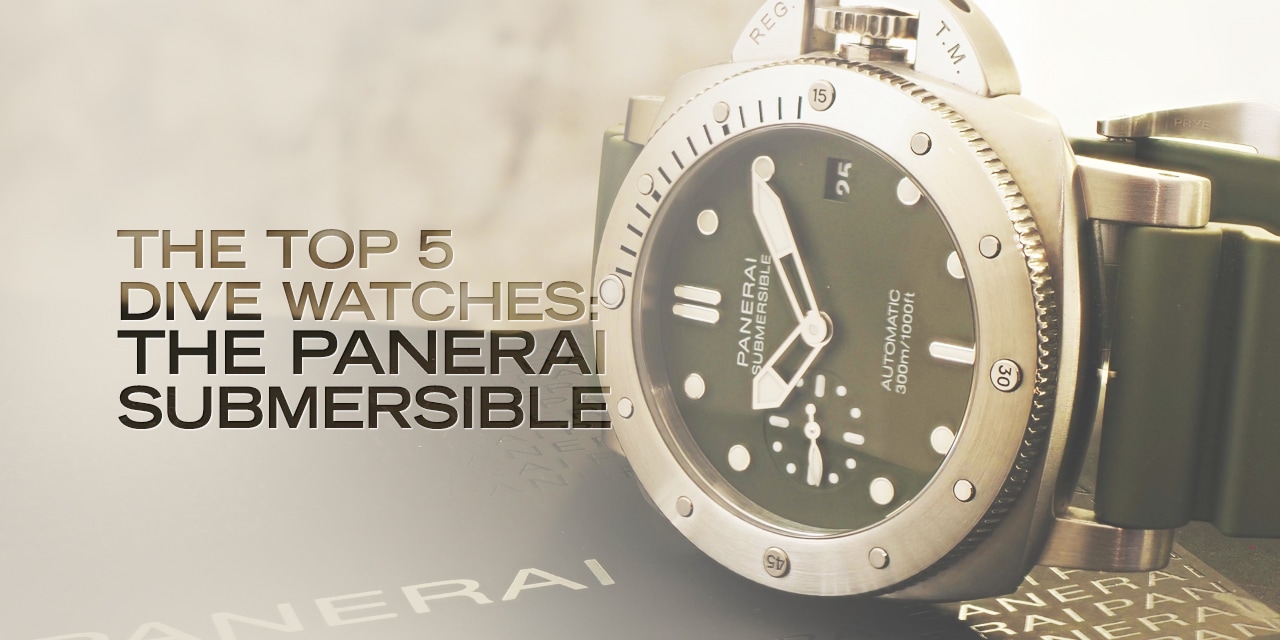The Top 5 Dive Watches: The Panerai Submersible
The Eiffel Tower, Mickey Mouse, The Statue of Liberty, Batman; some things are recognizable just by their silhouettes.
To that list we can easily add the Panerai Submersible. Its rounded square case is distinctive enough on its own, but when you then add the unmistakable crescent moon of its innovative crown guard, it offers as unambiguous a presence as horology allows.
In our recent article ranking the Top 5 Dive Watches of All Time, we placed the Submersible in the number four slot. It arrived originally as an offshoot of another iconic diver and was, for a time, listed in the same collection. These days, however, it exists as a standalone and is one of Panerai’s most successful creations.
Below, we take a closer look at this unique timepiece.
A Little History
Panerai’s history with dive watches dates back to 1936, and its relationship with the underwater world in general goes back even further than that.
The company was founded in Florence, Italy in 1860 by Giovanni Panerai who set up a boutique and workshop on the Ponte alle Grazie which also operated as the city’s first watchmaking school.
By 1915, Giovanni’s grandson, Guido had taken over both his grandfather’s business as well as the mechanical workshop owned by his wife’s family. It was in that year that Guido invented an illuminated gun sight which used small, sealed vessels containing a radium-226 and zinc sulfide powder he named ‘Radiomir’, from the Italian ‘radio mire’ or ‘radium sights’.
Patenting his discovery in 1916, Panerai came to the attention of the Regia Marina, the Royal Italian Navy, and was commissioned to produce a range of technical equipment for them, including gun sights, with the new compound illuminating the instruments.
By the 1930s and the introduction of underwater sabotage divisions in the Navy, Panerai was using Radiomir to light the depth gauges and compasses of these so-called ‘Frogmen’. But what they dearly needed was a watch that was both tough enough to survive the rigors of military marine operations and legible enough to be read in the murkiest of conditions.
In collaboration with Rolex, who were leading the industry with their waterproof Oyster cases, Panerai created such a watch in 1936, naming it after their ground-breaking luminescent paint, and the Radiomir was born.
However, it was not long after that the dangers of radium were unearthed and so Panerai set about finding a different, safer material to do the same job. This time they based their compound on tritium, a radioactive isotope of hydrogen and a low beta emitter, meaning its particles could not penetrate the skin. Not only that, it was actually more luminous than radium and so was the ideal substance for a new breed of watches.
In 1949, the first Luminor model made its debut, again named after the self-illuminating paint used on its dial. At first, these were almost identical to the existing Radiomir watches (and the prototypes still had Radiomir on the dial) but in 1955, the two sibling heads of the company, Giuseppe and Maria Giuseppe Panerai, applied for a patent for a ‘Tight Seal Device’, the crown protector which would become the signature feature of the Luminor, and one of the most distinguishable components of any watch from any manufacture.
The Submersible Surfaces
Throughout most of the 20th century, Panerai remained strictly a military supplier. But, in the early 1990s, the horology industry experienced a massive surge of interest in vintage-style military watches and the brand hesitantly decided to release a trio of models to the public based on some of their back catalog.
In 1993, they brought out three limited edition series. The Mare Nostrum was a chronograph founded on a 1950s prototype meant for deck officers which never saw production. The other two, the Luminor and Luminor Marina, were clearly designed around that iconic ‘40s classic and touted as fully-fledged dive models, the latter equipped with a running seconds subdial, the former without.
It was the Luminor range which would put Panerai on the map and the apocryphal story about Sylvester Stallone spotting one in a Rome store window and falling instantly in love is as well-known as it is inaccurate. (It was actually a friend of his, photographer Monty Shadow who discovered the watch and wore it while shooting celebrities at Hollywood parties, attracting Stallone and other superstars in the process). Nevertheless, when Sly wore his Luminor throughout his movie Daylight, it propelled both watch and brand into the stratosphere.
The problem was, when the International Organization for Standardization (ISO) issued their criteria for dive watches in 1996 (ISO 6425) the Luminor models didn’t qualify.
While they were certainly readable enough and without doubt capable of surviving to the required depth, they had no unidirectional rotating bezel marked with a minute scale; one of the ISO’s prerequisites.
As a result, Panerai, now owned by the Richemont Group who were quickly turning them into a legitimate manufacture producing in-house movements, released the first in a new line called the Submersible in 1998.
These not only lived up to the required standards, they massively exceeded them. Sharing the same aesthetic underpinnings as the Luminor, the Submersible beefed up the casing to be a stronger and more imposing presence. Together with the trademark crown bridge mechanism, this subsidiary collection boasted water resistance of at least 300m. Most importantly, the vital rotating bezel was present and correct, confirming this latest release was up to the job.
The Luminor Versus the Submersible
Even though the two lines lived under the same banner to begin with—the Submersible officially known as the Panerai Luminor Submersible at first—there were several key differences.
Along with the aforementioned bezel and generally sturdier build, it is easier to think of the Submersible as a Luminor with everything dialed up or stripped back.
Cases are thicker and broader, offering a squarer profile. The bracelets, usually a rubber strap, are wider too. Up front, the Luminor’s slender handset has been replaced with enormous skeletonized sword hands, and the hour markers are simple dots, with a single baton at the six and a double at the 12, replacing the famously huge 3/6/12 Arabic numerals of the Luminor.
All of these elements add up to make an example of the Submersible appear much larger on the wrist than an equivalent Luminor model even if they are, on paper, the same diameter. In addition, every model of the Submersible is fitted with a small running seconds dial at the 9 o’clock.
One factor the two collections do share, on the other hand, is some next level materials. Panerai has been at the forefront of developing some incredible metals for their watches, and you will find pieces crafted from proprietary alloys such as Carbotech (an all-black, carbon fiber-based substance), Goldtech (an intensely red variety of the precious metal containing copper and platinum) and eSteel (a steel alloy made up of 58.4% recycled metals) across both lines.
But then, true to form, the Submersible takes it a step or two further. One of the latest additions, the Elux LAB-ID is made from something called Ti-Ceramitech™, a titanium/ceramic hybrid which is 44% lighter than steel and with a fracture toughness 10-times that of ceramic alone.
Yet, where the Luminor collection boasts some impressive complications, including GMT, Equation of Time, Perpetual Calendar and Moonphase models, the Submersible is, for the vast majority, strictly time and date only—underlining its more purpose driven appeal.
The Submersible was separated into its own independent range in 2019 and celebrated its liberation with yet another new material, this time Panerai’s own BMG-Tech. Standing for Bulk Metallic Glass, it is essentially a glass-like composite containing zirconium, aluminum, copper, titanium and nickel which gives exceptional robustness, corrosion resistance, and protection from shocks and magnetic fields.
It is simply one more example in a very long history of progressive technological advances for which Panerai can claim credit, confirming their reputation as one of the most innovative watchmakers in existence today.
Featured Photo: Natalya Rostun via Pexels (cc).






